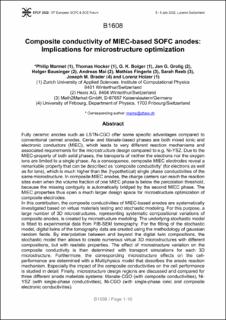Bitte benutzen Sie diese Kennung, um auf die Ressource zu verweisen:
https://doi.org/10.21256/zhaw-26055| Publikationstyp: | Konferenz: Paper |
| Art der Begutachtung: | Peer review (Abstract) |
| Titel: | Composite conductivity of MIEC-based SOFC anodes : implications for microstructure optimization |
| Autor/-in: | Marmet, Philip Hocker, Thomas Boiger, Gernot K. Grolig, Jan G. Bausinger, Holger Mai, Andreas Fingerle, Mathias Reeb, Sarah Brader, Joseph M. Holzer, Lorenz |
| et. al: | No |
| DOI: | 10.21256/zhaw-26055 |
| Angaben zur Konferenz: | 15th European SOFC & SOE Forum 2022, Lucerne, Switzerland, 5-8 July 2022 |
| Erscheinungsdatum: | 5-Jul-2022 |
| Verlag / Hrsg. Institution: | ZHAW Zürcher Hochschule für Angewandte Wissenschaften |
| Verlag / Hrsg. Institution: | Winterthur |
| Sprache: | Englisch |
| Schlagwörter: | EFCF2022; SOFC; CGO; Titanates; Digital microstructure design; Stochastic microstructure digital twin |
| Fachgebiet (DDC): | 621.3: Elektro-, Kommunikations-, Steuerungs- und Regelungstechnik |
| Zusammenfassung: | Fully ceramic anodes such as LSTN-CGO offer some specific advantages compared to conventional cermet anodes. Ceria- and titanate-based phases are both mixed ionic and electronic conductors (MIEC), which leads to very different reaction mechanisms and associated requirements for the microstructure design compared to e.g. Ni-YSZ. Due to the MIEC-property of both solid phases, the transports of neither the electrons nor the oxygen ions are limited to a single phase. As a consequence, composite MIEC electrodes reveal a remarkable property that can be described as ‘composite conductivity’ (for electrons as well as for ions), which is much higher than the (hypothetical) single phase conductivities of the same microstructure. In composite MIEC anodes, the charge carriers can reach the reaction sites even when the volume fraction of one MIEC phase is below the percolation threshold, because the missing contiguity is automatically bridged by the second MIEC phase. The MIEC properties thus open a much larger design space for microstructure optimization of composite electrodes. In this contribution, the composite conductivities of MIEC-based anodes are systematically investigated based on virtual materials testing and stochastic modeling. For this purpose, a large number of 3D microstructures, representing systematic compositional variations of composite anodes, is created by microstructure modeling. The underlying stochastic model is fitted to experimental data from FIB-SEM tomography. For the fitting of the stochastic model, digital twins of the tomography data are created using the methodology of gaussian random fields. By interpolation between and beyond the digital twin compositions, the stochastic model then allows to create numerous virtual 3D microstructures with different compositions, but with realistic properties. The effect of microstructure variation on the composite conductivity is then determined with transport simulations for each 3D microstructure. Furthermore, the corresponding microstructure effects on the cell-performance are determined with a Multiphysics model that describes the anode reaction mechanism. Especially the impact of the composite conductivities on the cell performance is studied in detail. Finally, microstructure design regions are discussed and compared for three different anode materials systems: titanate-CGO (with composite conductivities), Ni-YSZ (with single-phase conductivities), Ni-CGO (with single-phase ionic and composite electronic conductivities). |
| URI: | https://digitalcollection.zhaw.ch/handle/11475/26055 |
| Volltext Version: | Publizierte Version |
| Lizenz (gemäss Verlagsvertrag): | Lizenz gemäss Verlagsvertrag |
| Departement: | School of Engineering |
| Organisationseinheit: | Institute of Computational Physics (ICP) |
| Publiziert im Rahmen des ZHAW-Projekts: | Versatile oxide fuel cell microstructures employing WGS active titanate anode current collectors compatible to ferritic stainless steel interconnects (VOLTA) GeoCloud – Simulation Software for Cloud-based Digital Microstructure Design of New Fuel Cell Materials |
| Enthalten in den Sammlungen: | Publikationen School of Engineering |
Dateien zu dieser Ressource:
| Datei | Beschreibung | Größe | Format | |
|---|---|---|---|---|
| 2022_Marme-etal_Composite-conductivity-MIEC-based-SOFC-anodes.pdf | 1.59 MB | Adobe PDF |  Öffnen/Anzeigen |
Zur Langanzeige
Marmet, P., Hocker, T., Boiger, G. K., Grolig, J. G., Bausinger, H., Mai, A., Fingerle, M., Reeb, S., Brader, J. M., & Holzer, L. (2022, July 5). Composite conductivity of MIEC-based SOFC anodes : implications for microstructure optimization. 15th European SOFC & SOE Forum 2022, Lucerne, Switzerland, 5-8 July 2022. https://doi.org/10.21256/zhaw-26055
Marmet, P. et al. (2022) ‘Composite conductivity of MIEC-based SOFC anodes : implications for microstructure optimization’, in 15th European SOFC & SOE Forum 2022, Lucerne, Switzerland, 5-8 July 2022. Winterthur: ZHAW Zürcher Hochschule für Angewandte Wissenschaften. Available at: https://doi.org/10.21256/zhaw-26055.
P. Marmet et al., “Composite conductivity of MIEC-based SOFC anodes : implications for microstructure optimization,” in 15th European SOFC & SOE Forum 2022, Lucerne, Switzerland, 5-8 July 2022, Jul. 2022. doi: 10.21256/zhaw-26055.
MARMET, Philip, Thomas HOCKER, Gernot K. BOIGER, Jan G. GROLIG, Holger BAUSINGER, Andreas MAI, Mathias FINGERLE, Sarah REEB, Joseph M. BRADER und Lorenz HOLZER, 2022. Composite conductivity of MIEC-based SOFC anodes : implications for microstructure optimization. In: 15th European SOFC & SOE Forum 2022, Lucerne, Switzerland, 5-8 July 2022. Conference paper. Winterthur: ZHAW Zürcher Hochschule für Angewandte Wissenschaften. 5 Juli 2022
Marmet, Philip, Thomas Hocker, Gernot K. Boiger, Jan G. Grolig, Holger Bausinger, Andreas Mai, Mathias Fingerle, Sarah Reeb, Joseph M. Brader, and Lorenz Holzer. 2022. “Composite Conductivity of MIEC-Based SOFC Anodes : Implications for Microstructure Optimization.” Conference paper. In 15th European SOFC & SOE Forum 2022, Lucerne, Switzerland, 5-8 July 2022. Winterthur: ZHAW Zürcher Hochschule für Angewandte Wissenschaften. https://doi.org/10.21256/zhaw-26055.
Marmet, Philip, et al. “Composite Conductivity of MIEC-Based SOFC Anodes : Implications for Microstructure Optimization.” 15th European SOFC & SOE Forum 2022, Lucerne, Switzerland, 5-8 July 2022, ZHAW Zürcher Hochschule für Angewandte Wissenschaften, 2022, https://doi.org/10.21256/zhaw-26055.
Alle Ressourcen in diesem Repository sind urheberrechtlich geschützt, soweit nicht anderweitig angezeigt.